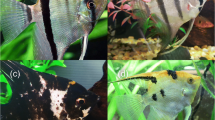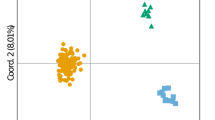Abstract
In many studies involving microsatellites cross-species amplification, primers designed for one (source) species are used to amplify homologous loci in related (target) species. However, it is not clear how closely related the species must be to attain significant success. Genetic divergence is a clear and easy way to assess similarity between species and provides an accurate measure of their evolutionary distance. Eight Mediterranean target species of the family Serranidae were analysed using twelve primers developed for Serranus cabrilla. Additionally, two mitochondrial genes (12S rRNA and 16S rRNA) were chosen on the basis of their extensive use in phylogenetic and evolutionary analyses to compute genetic divergence between the species. Significant negative correlations were found between genetic divergence and both cross-species amplification and maintained polymorphism of microsatellite markers, which could be generalized by gathering information from different fish studies. The success of obtaining amplifiable and polymorphic microsatellite loci can be a priori approximated knowing the mtDNA genetic divergence between a given source and target species using our inferred regression equations.

Similar content being viewed by others
References
Almada F, Almada VC, Guillemaud T, Wirtz P (2005) Phylogenetic relationships of the north-eastern Atlantic and Mediterranean blenniids. Biol J Linn Soc 86:283–295. doi: 10.1111/j.1095-8312.2005.00519.x
Arigoni S, Largiadèr CR (2000) Isolation and characterization of microsatellite loci from the ocellated wrasse Symphodus ocellatus (Percifromes: Labridae) and their applicability to related taxa. Mol Ecol 9:2166–2169. doi: 10.1046/j.1365-294X.2000.10537.x
Aurelle D, Guillemaud T, Afonso P, Morato T, Wirtz P, Santos RS, Cancela ML (2003) Genetic study of Coris julis (Osteichtyes, Perciformes, Labridae) evolutionary history and dispersal abilities. Compt Rendus Biol 326:771–785
Broughton RE, Milam JE, Roe BA (2001) The complete sequence of the zebrafish (Danio rerio) mitochondrial genome and evolutionary patterns in vertebrate mitochondrial DNA. Genome Res 11:1958–1967
Brown RC, Tsalavouta M, Terzoglou V, Magoulas A, McAndrew J (2005) Additional microsatellites for Sparus aurata and cross-species amplification within the Sparidae family. Mol Ecol Notes 5:605–607. doi: 10.1111/j.1471-8286.2005.01007.x
Calcagnotto D, Russello M, DeSalle R (2001) Isolation and characterization of microsatellite loci in Piaractus mesopotamicus and their applicability in other Serrasalminae fish. Mol Ecol Notes 1:245–247. doi: 10.1046/j.1471-8278.2001.00091.x
Calcagnotto D, Schaefer SA, DeSalle R (2005) Relationships among characiform fishes inferred from analysis of nuclear and mitochondrial gene sequences. Mol Phylogenet Evol 36:135–153
Carreras-Carbonell J, Macpherson E, Pascual M (2004) Isolation and characterization of microsatellite loci in Tripterygion delaisi. Mol Ecol Notes 4:438–439. doi: 10.1111/j.1471-8286.2004.00688.x
Carreras-Carbonell J, Macpherson E, Pascual M (2005) Rapid radiation and cryptic speciation in Mediterranean triplefin blennies (Pisces: Tripterygiidae) combining multiple genes. Mol Phylogenet Evol 37:751–761
Carreras-Carbonell J, Macpherson E, Pascual M (2006) Characterization of twelve microsatellite markers in Serranus cabrilla. Mol Ecol Notes 6:204–206. doi: 10.1111/j.1471-8286.2005.01193.x
Castresana J (2000) Selection of conserved blocks from multiple alignments for their use in phylogenetic analysis. Mol Biol Evol 17:540–552
Chapman RW, Sedberry GR, Koenig CC, Eleby BM (1999) Stock identification of gag,Mycteroperca microlepis:along the South-east coast of the United States. Mar Biotechnol 1:137–146
Craig MT, Pondella II DJ, Hafner JC (2001) On the status of the serranid fish genus Epinephelus: evidence for paraphyly based upon 16S rDNA sequence. Mol Phylogenet Evo 19:121–130
Das P, Barat A, Meher PK, Ray PP, Majumdar D (2005) Isolation and characterization of polymorphic microsatellites in Labeo rohita and their cross-species amplification in related species. Mol Ecol Notes 5:231–233. doi: 10.1111/j.1471-8286.2005.00905.x
De Innocentiis S, Sola L, Cataudella S, Bentzen P (2001) Allozyme and microsatellite loci provide discordant estimates of population differentiation in the endangered dusky grouper (Epinephelus marginatus) within the Mediterranean Sea. Mol Ecol 10:2163–2175. doi: 10.1046/j.1365-294X.2001.01371.x
Doiron S, Bernatchez L, Blier PU (2002) A comparative mitogenomic analysis of the potential adaptive value of Arctic Charr mtDNA introgression in Brook Charr populations (Salvelinus fontinalis mitchill). Mol Biol Evol 19:1902–1909
Estoup A, Largiadèr CR, Perrot E, Chourrout D (1996) Rapid one–tube DNA extraction for reliable PCR detection of fish polymorphic markers and transgenes. Mol Mar Biol Bioltechnol 5:295–298
Feulner PGD, Kirschbaum F, Tiedemann R (2005) Eighteen microsatellite loci for endemic African weakly electric fish (Campylomormyrus, Mormyridae) and their cross-species applicability among related taxa. Mol Ecol Note 5:446–448. doi: 10.1111/j.1471-8286.2005.00958.x
Gemmell NJ, Allen PJ, Goodman SJ, Reed JZ (1997) Interspecific microsatellite markers for the study of pinniped populations. Mol Ecol 6:661–666. doi: 10.1046/j.1365-294X.1997.00235.x
Gilles A, Lecointre G, Miquelis A, Loerstcher M, Chappaz R, Brun G (2001) Partial combination applied to phylogeny of European cyprinids using the mitochondrial control region. Mol Phylogent Evol 19:22–33
Goudet J (1995) FSTAT (Version 1.2): A computer program to calculate F- statistics. Jf Heredity 86:485–486
Guillemaud T, Almada F, Santos RS, Cancela ML (2000) Interspecific utility of microsatellites in fish: a case study of (CT) n and (GT) n markers in the Shanny Lipophrys pholis (Pisces: Blenniidae) and their use in other Blennioidei. Mar Biotechnol 2:248–253
Guo XH, Liu SJ, Liu Y (2003) Comparative analysis of the mitochondrial DNA control region in cyprinids with different ploidy level. Aquaculture 224:25-38
Hanel R, Westneat MW, Strumbauer C (2002) Phylogenetic relationships, evolution of broodcare behaviour, and geographic speciation in the wrasse tribe Labrini. J Mol Evol 55:776–789
Holmen J, Vollestad LA, Jakobsen KS, Primmer CR (2005) Cross-species amplification of zebrafish and central stoneroller microsatellite loci in six other cyprinids. J Fish Biol 66:851–859. doi: 10.1111/j.0022-1112.2005.00637.x
Hutter CM, Schug MD, Aquadro CF (1998) Microsatellite variation in Drosophila melanogaster and Drosophila simulans: a reciprocal test of the ascertainment bias hypothesis. Mol Biol Evol 15:1620–1636
Jarne P, Lagoda PJL (1996) Microsatellites, from molecules to populations and back. Trends Ecol Evol 11:424–429
Kocher TD, Thomas WK, Meyer A, Edwards SV, Pääbo S, Villablanca FX, Wilson AC (1989) Dynamics of mitochondrial DNA evolution in animals. Proc Natl Acad Sci USA 86:6196– 6200
Martinez-Cruz B, David VA, Godoy JA, Negro JJ, O’Brien SJ, Johnson WE (2002) Eighteen polymorphic microsatellite markers for the highly endangered Spanish imperial eagle (Aquila adalberti) and related species. Mol Ecol Notes 2:323–326. doi: 10.1046/j.1471-8286.2002.00231.x
Moore SS, Sargeant LL, King TJ, Mattick JS, Georges M, Hetzel DJS (1991) The conservation of dinucleotide microsatellites among mammalian genomes allows the use of heterologous PCR primer pairs in closely related species. Genomics 10:654–660
Orrell TM, Carpenter KE (2004) A phylogeny of the fish family Sparidae (porgies). inferred from mitochondrial sequence data. Mol Phylogenet Evol 32:425-434
Palti Y, Fincham MR, Rexroad III CE (2002). Characterization of 38 polymorphic microsatellite markers for rainbow trout (Oncorhynchus mykiss). Mol Ecol Notes 2:449–452. doi: 10.1046/j.1471-8286.2002.00274.x
Palumbi S, Martin A, Romano A, McMillan WO, Stice L, Grabowski G (1991) The simple fool’s guide to PCR. Department of Zoology and Kewalo Marine Laboratory University of Hawaii, Honolulu, HI
Peakall R, Gilmore S, Keys W, Morgante M, Rafalski A (1998) Cross-species amplification of Soybean (Glycine max) simple sequence repeats (SSRs) within the genus and other legume genera: implications for the transferability of SSRs in Plants. Mol Biol Evol 15:1275–1287
Primmer CR, Moller AP, Ellegren H (1996) A wide-range survey of cross-species microsatellite amplification in birds. Mol Ecol 5:365–378. doi: 10.1046/j.1365–294X.1996.00092.x
Primmer CR, Painter JN, Koskinen MT, Palo JU, Merilä J (2005) Factors affecting avian cross-species microsatellite amplification. J Avian Biol 36:348–360
Queller DC, Strassmann JE, Hughes CR (1993) Microsatellites and kinship. Trends Ecol Evol 8:53–61
Simons AM, Mayden. R. L. (1999) Phylogenetic relationships of the North American cyprinids and assessment of homology of the open posterior myodome. Copeia 1:13-21
Smith WL, Wheeler WC (2004) Polyphyly of the mail-cheeked fishes (Teleostei: Scorpaeniformes): evidence from mitochondrial and nuclear sequence data. Mol Phylogent Evol 32:627–646
Sullivan JP, Lavoue S, Hopkins CD (2000) Molecular systematics of the African electric fishes (Mormyroidea: teleostei) and a model for the evolution of their electric organs. J Exp Biol 203:665–683
Swofford DL (2001) PAUP*. Phylogenetic Analysis Using Parsimony (* and Other Methods), Version 4. Sinauer Associates, Sunderland, MA
Thompson JD, Gibson TJ, Plewniak F, Jeanmougin F, Higgins DG (1997) The ClustalX windows interface: flexible strategies for multiple sequence alignment aided by quality analysis tools. Nucleic Acids Res 25:4876–4882
Tong J, Wang Z, Yu X, Wu Q, Chu KH (2002) Cross-species amplification in silver carp and bighead carp with microsatellite primers of common carp. Mol Ecol Not 2:245–247. doi: 10.1046/j.1471-8286.2002.00214.x
Wright JM, Bentzen P (1994) Microsatellites: genetic markers of the future. Rev Fish Biol Fisheries 4:384–388
Zardoya R, Garrido-Pertierra A, Bautista JM (1995) The complete nucleotide sequence of the mitochondrial DNA genome of the rainbow trout, Oncorhynchus mykiss. J Mol Evol 41:942–951
Zatcoff MS, Ball AO, Chapman RW (2002) Characterization of polymorphic microsatellite loci from black grouper, Mycteroperca bonaci (Teleostei: Serranidae). Mol Ecol Notes 2:217–219. doi: 10.1046/j.1471-8286.2002.00194.x
Acknowledgements
We thank A. Machordom for her helpful comments on the manuscript. We are grateful to Sr. Acevedo, K. Ballesteros, J. Chías, D. Díaz, J. Fabré, E. Sala, O. Sanz, and M. Zabala for providing us with samples from different locations. We are also especially indebted to A. Garcia-Rubies for his helpful comments on the statistical analyses. This research was supported by a Predoctoral fellowship from the Spanish Ministerio de Educación y Ciencia to J.C. (AP2001-0225). Research was funded by projects CTM2004-05265, CGL2006-13423 from the Spanish Ministerio de Educación y Ciencia and 119/2003 from the Spanish Ministerio de Medio Ambiente. The authors are part of the research groups 2005SGR-00995 and 2005SGR-00277 of the Generalitat de Catalunya.
Author information
Authors and Affiliations
Corresponding author
Electronic supplementary material
Below is the link to the electronic supplementary material.
Rights and permissions
About this article
Cite this article
Carreras-Carbonell, J., Macpherson, E. & Pascual, M. Utility of pairwise mtDNA genetic distances for predicting cross-species microsatellite amplification and polymorphism success in fishes. Conserv Genet 9, 181–190 (2008). https://doi.org/10.1007/s10592-007-9322-2
Received:
Accepted:
Published:
Issue Date:
DOI: https://doi.org/10.1007/s10592-007-9322-2




